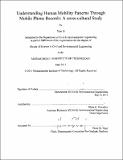| dc.contributor.advisor | Marta C. González. | en_US |
| dc.contributor.author | Ji, Yan, Ph. D. Massachusetts Institute of Technology | en_US |
| dc.contributor.other | Massachusetts Institute of Technology. Dept. of Civil and Environmental Engineering. | en_US |
| dc.date.accessioned | 2011-11-01T19:55:02Z | |
| dc.date.available | 2011-11-01T19:55:02Z | |
| dc.date.copyright | 2011 | en_US |
| dc.date.issued | 2011 | en_US |
| dc.identifier.uri | http://hdl.handle.net/1721.1/66867 | |
| dc.description | Thesis (S.M.)--Massachusetts Institute of Technology, Dept. of Civil and Environmental Engineering, 2011. | en_US |
| dc.description | Cataloged from PDF version of thesis. | en_US |
| dc.description | Includes bibliographical references (p. 97-100). | en_US |
| dc.description.abstract | In this thesis, I present a cross-cultural study on human's trip length distribution and how it might be influenced by regional socio-economic factors, such as population density, income and unemployment rate. Mobile phone records contain very detailed calling information of the spatiotemporal localization of hundreds of thousands of users, which can be used as proxies for human trips. The traveling behaviors of 24 autonomous regions in San Francisco (5 regions), Dominican Republic (3 regions) and a European country (16 regions) are studied through these rich mobile phone data sets. We found that people in different regions have very heterogeneous aggregate traveling patterns (trip length distribution) which can be generally grouped into four distinct families. The result of Self-organizing map shows that the trip length distribution has a certain degree of correlation to population density, which sparks our interests to conduct a thorough research on factors such as population density and income that can potentially influence the trip length distribution and human's traveling behavior. Using a double exponential function to fit the radius of gyration distribution (i.e. a proxy to the trip length distribution), we are able to characterize human's traveling behavior with four parameters. By applying principle component analysis, the parameter space is transformed orthogonally and two principal components which contribute most to the variance of sample set are extracted. We tempted to find the regression relationship between population density and each of the components. However, the R² is not enough high for estimation purposes. With the extensive information source regarding household income, median age, unemployment rate, we were able to conduct a multiple regression analysis in San Francisco Bay area. Using radius of gyration as regressand, population density, income, age, and unemployment rate as regressors, we found the R² is over 30%, which is sufficiently good for cross-sectional data analysis. Additionally, the significant estimated coefficients indicate that people living in wealthier and unpopulated areas tend to travel more frequently and make long distance trips. Furthermore, descriptive comments are provided for the connection between parameters in the fitting function and population density and income. | en_US |
| dc.description.statementofresponsibility | by Yan Ji. | en_US |
| dc.format.extent | 100 p. | en_US |
| dc.language.iso | eng | en_US |
| dc.publisher | Massachusetts Institute of Technology | en_US |
| dc.rights | M.I.T. theses are protected by
copyright. They may be viewed from this source for any purpose, but
reproduction or distribution in any format is prohibited without written
permission. See provided URL for inquiries about permission. | en_US |
| dc.rights.uri | http://dspace.mit.edu/handle/1721.1/7582 | en_US |
| dc.subject | Civil and Environmental Engineering. | en_US |
| dc.title | Understanding human mobility patterns through mobile phone records : a cross-cultural study | en_US |
| dc.type | Thesis | en_US |
| dc.description.degree | S.M. | en_US |
| dc.contributor.department | Massachusetts Institute of Technology. Department of Civil and Environmental Engineering | |
| dc.identifier.oclc | 758166643 | en_US |
